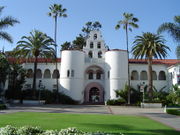California State University
| California State University | |
|---|---|
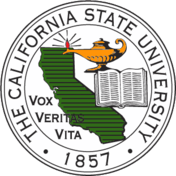 |
|
| Motto | Vox Veritas Vita (Latin) |
| Motto in English | "Voice Truth Life" (Speak the truth as a way of life.) |
| Established | 1857 |
| Type | Public University System |
| Endowment | US$ 717 million (2008/2009) [1] |
| Chancellor | Charles B. Reed |
| Academic staff | 44,000 |
| Students | 417,112 |
| Location | Long Beach, California, United States |
| Campus | 23 campuses |
| Colors | Red & White |
| Affiliations | State of California |
| Website | CalState.edu CalState.ca.gov |
The California State University (CSU) is one of three public higher education systems in the state of California, the other two being the University of California system and the California Community College system. It is incorporated as The Trustees of the California State University. The California State University system headquarters are at 401 Golden Shore in downtown Long Beach.[2]
The CSU system is composed of 23 campuses and has over 417,112 students supported by 47,000 faculty members and staff.[3] It is the largest senior system of higher education in the United States.[4]
CSU prepares about 60 percent of the teachers in the state, 40 percent of the engineering graduates, and more graduates in business, agriculture, communications, health, education and public administration than all other California universities and colleges combined. Altogether, about half the bachelor's degrees and a third of the master's degrees awarded annually in California are from the CSU.
Since 1961 nearly 2.5 million alumni have received a bachelor's, master's or doctoral degree from the university system. CSU offers more than 1,800 degree programs in some 240 subject areas.
Contents |
History
Today's California State University system is the direct descendant of the California State Normal School (now San Jose State University), a normal school established by the California Legislature on May 2, 1862. The California State Normal School was itself derived from the City of San Francisco's Minns Evening Normal School (founded in 1857) a normal school legislature dropped the word "California" from the name of the San Jose and Los Angeles schools, renaming them "State Normal Schools." Later Chico (1887), San Diego (1897), and other schools became part of the State Normal School system. In 1919, the State Normal School at Los Angeles became the Southern Branch of the University of California (now the University of California, Los Angeles). In 1921, the State Normal Schools became the State Teachers Colleges. By this time most of the campuses started to become identified by their city names plus the word "state" (e.g., "San Jose State," "San Diego State," "San Francisco State").
In 1935, the State Teachers Colleges became the California State Colleges and were administered by the California State Department of Education in Sacramento. The Donahoe Higher Education Act of 1960 gave the system greater autonomy from the State of California.
The postwar period brought a great expansion in the number of colleges in the system. Campuses in Los Angeles, Sacramento, and Long Beach were added between 1947 and 1949. Then seven more were authorized to be built between 1957 and 1960. Six more campuses joined the system after the establishment of the Donohoe Higher Education Act in 1960 bringing the total number to 23.
In 1972 the system became The California State University and Colleges, and all of the campuses were renamed with the words "California State University" in their names. Former San Diego State University student body president Calvin Robinson wrote the bill, signed into law by Ronald Reagan, that allowed every California State University the option to revert the schools back to their pre-1972 names: San Jose State, San Diego State, San Francisco State, etc. In 1982, the CSU system dropped the word "colleges" from its name.
Today the campuses of the CSU include comprehensive and polytechnic universities and the only Maritime Academy in the western United States that receives aid from the federal Maritime Administration.
Governance
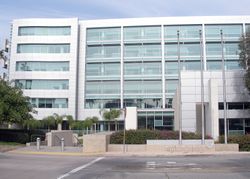
The governance structure of the California State University is largely determined by state law. The California State University is ultimately administered by the 25 member Board of Trustees of the California State University. The Trustees appoint the Chancellor of the California State University, who is the chief executive officer of the system, and the Presidents of each campus, who are the chief executive officers of their respective campuses.
The Academic Senate of the California State University, made up of elected representatives of the faculty from each campus, recommends academic policy to the Board of Trustees through the Chancellor.
Board of Trustees
The California State University is administered by the 25 member Board of Trustees (BOT). The BOT is composed of:[5][6]
- 16 members that are appointed by the Governor of California with the consent of the Senate
- two students from the California State University appointed by the Governor
- a tenured faculty member appointed by the Governor selected from a list of names from the Academic Senate
- a representative of the alumni associations of the state university selected for a two-year term by the alumni council of the California State University
- 5 ex officio members:
- Governor
- Lieutenant Governor
- Speaker of the Assembly
- State Superintendent of Public Instruction
- the CSU Chancellor
Members
Membership of the Board of Trustees: Ex Officio trustees
- Arnold Schwarzenegger, Governor of California
- Abel Maldonado, Lieutenant Governor of California
- John Pérez, Speaker of the Assembly
- Jack O'Connell, State Superintendent of Public Instruction
- Charles B. Reed, CSU Chancellor
Appointed trustees:
- Roberta Achtenberg
- Jeffrey L. Bleich
- Herbert L. Carter
- Carol R. Chandler
- Debra S. Farar
- Kenneth Fong
- Margaret Fortune
- George G. Gowgani
- Curtis Grima
- Melinda Guzman
- William Hauck
- Raymond Holdsworth, Jr.
- Linda A. Lang
- Bob Linscheid
- Peter Mehas
- Henry Mendoza
- Lou Monville
- Craig R. Smith
- Russel D. Statham
- Glen Toney
- Kyriakos Tsakopoulos
Chancellor
The position of the Chancellor is declared by statute, and is defined by resolutions of the BOT. The delegation of authority from the BOT to the Chancellor has historically been controlled by a BOT resolution titled "Statement of General Principles in the Delegation of Authority and Responsibility" of August 4, 1961, and is now controlled by the Standing Orders of the Board of Trustees of the California State University. The Chancellor is the chief executive officer, and all Presidents report directly to the Chancellor.
Chancellors
- Buell Gallagher (1961–1962)
- Glenn S. Dumke (1962–1982)
- W. Ann Reynolds (1982–1990)
- Ellis E. McCune [Acting] (1990–1991)
- Barry Munitz (1991–1998)
- Charles B. Reed (1998-current)
Endowment
The California State University's permanent, collective endowment has grown to $874 million U.S. dollars as of the close of the 2006-2007 academic year.[7] In addition, each of the 23 campuses of the CSU raise their own funds through donations and other external funding, and each campus controls its own separate endowment funds not counted in the above endowment amount.
| Rank | Institution | City | 2007 Endowment[8] ($000 USD) |
2008 Endowment[8] ($000 USD) |
2009 Endowment[9] ($000 USD) |
Percent change from previous year |
|---|---|---|---|---|---|---|
| 1 | California Polytechnic State University | San Luis Obispo | $ 181,530 | $ 166,179 | $ 130,947 | -21 % |
| 2 | San Diego State University | San Diego | $ 99,853 | $ 115,090 | - | 15 % |
| 3 | California State University, Fresno | Fresno | $ 112,901 | $ 104,645 | $ 91,426 | -13 % |
| 4 | California State University, Northridge | Northridge, Los Angeles | $ 60,227 | $ 55,379 | $ 48,920 | -12 % |
| 5 | San Francisco State University | San Francisco | $ 51,202 | $ 47,179 | $ 43,731 | -7 % |
| 6 | San Jose State University | San Jose | $ 50,020 | $ 50,108 | $ 40,517 | -19 % |
| 7 | California State University, Long Beach | Long Beach | $ 36,072 | $ 36,616 | $ 31,070 | -15 % |
| 8 | California State University, Chico | Chico | $ 35,741 | $ 34,656 | - | -3.0 % |
| 9 | California State Polytechnic University, Pomona | Pomona | $ 33,717 | $ 33,201 | $ 27,636 | -17 % |
| 10 | Sonoma State University | Rohnert Park | $ 37,417 | $ 35,602 | $ 26,037 | -27 % |
| 11 | California State University, Sacramento | Sacramento | $ 19,155 | $ 21,412 | $ 19,712 | -8 % |
| 12 | California State University, Fullerton | Fullerton | $ 17,592 | $ 20,022 | $ 18,960 | -5 % |
| 13 | Humboldt State University | Arcata | $ 18,797 | $ 18,447 | $ 15,700 | -15 % |
| 14 | California State University, San Bernardino | San Bernardino | $ 12,651 | $ 14,190 | $ 13,401 | -6 % |
| 15 | California State University, Los Angeles | Los Angeles | $ 16,553 | $ 15,091 | $ 13,224 | -12 % |
| 16 | California State University, Bakersfield | Bakersfield | $ 16,460 | $ 16,415 | $ 13,013 | -21 % |
| 17 | California State University, San Marcos | San Marcos | $ 15,158 | $ 16,222 | $ 12,992 | -20 % |
| 18 | California State University, East Bay | Hayward | $ 9,762 | $ 9,179 | - | -6.0 % |
| 19 | California State University, Stanislaus | Turlock | $ 11,000 | $ 11,084 | $ 8,422 | -24 % |
| NR | California State University Office of the Chancellor | Long Beach | $ 9,744 | $ 9,210 | $ 7,913 | -14 % |
| 20 | California State University, Monterey Bay | Seaside | $ 4,801 | $ 7,014 | $ 7,676 | 9 % |
| 21 | California State University, Channel Islands | Camarillo | $ 7,722 | $ 7,253 | $ 6,242 | -14 % |
| 22 | California State University, Dominguez Hills | Carson | $ 6,730 | $ 6,567 | $ 6,033 | -8 % |
| 23 | California Maritime Academy | Vallejo | $ 1,837 | $ 1,844 | $ 1,882 | 2 % |
Faculty
During the fall 2004 semester the system employed 11,069 full-time faculty members. The vast majority, 68.3% were tenured or tenure tracked with 59.2% having tenure. Professors comprised 86.6% of faculty members with a plurality, 43.6% being full professors. Associate professors consitituted 18.6% and Assistant professors 24.4% of faculty members while 13.4% were instructors and lecturers. The percentage of full professors declined 31.4% since fall of 1999, while that of assistant professors has risen 57.4%.[10]
The CSU system requires faculty to sign a loyalty oath dating from the Cold War. Some campuses (most recently CSU Fullerton) have refused to hire academics who have refused to sign one, although others have provided for accommodations such as signing statements. Quakers have been particular victims of this policy.[11]
Salary
The average faculty salary was roughly $74,000 as of Spring 2007.[12] As of April 2007, the faculty union and CSU have reached an agreement increasing faculty base salaries by 20.7%, boosting the average faculty salary from $74,000 to $91,000 by 2011. Salaries for full-professors will increase from $86,000 to $105,000.[12] While this pay increase will provide a plurality of faculty members with six figure salaries, current CSU faculty salaries remain roughly 15% below the average for "comparable schools." Meanwhile salaries for all presidents have been raised above $300,000 in order to remain competitive with similar schools.[13] As of Fall 2004 average salaries were as follows:
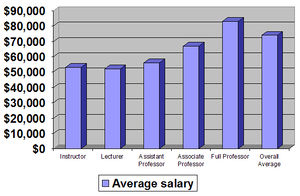
| Data[14] | Lecturer | Instructor | Assistant Professor | Associate Professor | Full Professor |
|---|---|---|---|---|---|
| Average salary[10] | $52,987 | $52,078 | $55,788 | $67,306 | $83,502 |
| Minimum salary[15] | $34,356 | $40,656 | $48,720 | $55,944 | $70,680 |
| Maximum salary[15] | $125,820 | $54,708 | $109,272 | $120,060 | $125,820 |
| Percent of faculty[10] | 13.28% | 0.10% | 24.45% | 18.62% | 43.55% |
Enrollment
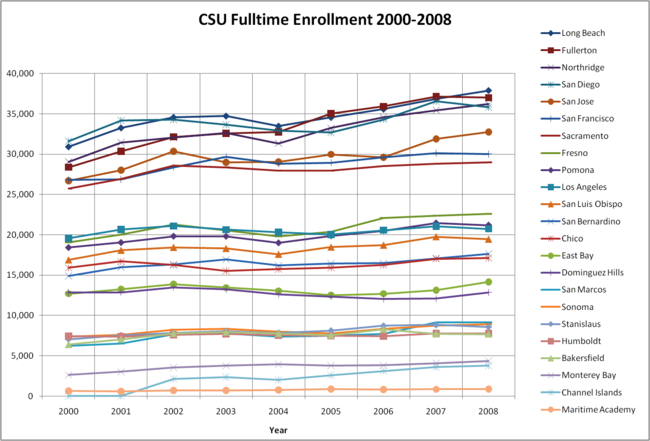
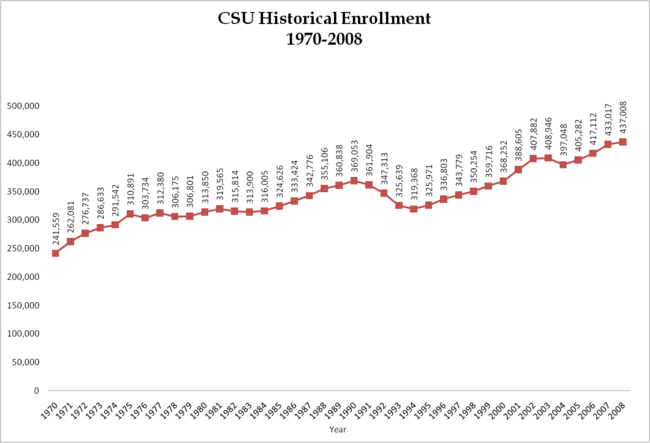
Campuses
The CSU is composed of the following 23 campuses listed here by order of the year founded:
| Campus | Location | Founded | Campus Area in Acres | Enrollment
(Full time |
Budget 2009-2010[17] | Athletics Affiliation | Athletics Nickname (Conference) |
|---|---|---|---|---|---|---|---|
| San Jose State University | San Jose | 1857 | 154 | 26,291 | 264,661,972 | NCAA Division I | San Jose State Spartans (WAC) |
| California State University, Chico | Chico | 1887 | 119 | 15,963 | 158,793,102 | NCAA Division II | Wildcats (CCAA) |
| San Diego State University | San Diego | 1897 | 270 | 30,821 | 322,889,316 | NCAA Division I | San Diego State Aztecs (MWC) |
| San Francisco State University | San Francisco | 1899 | 134 | 24,692 | 275,409,849 | NCAA Division II | Gators (CCAA) |
| California Polytechnic State University | San Luis Obispo | 1901 | 9,678 | 18,499 | 211,492,088 | NCAA Division I | Mustangs (Big West) |
| California State University, Fresno | Fresno | 1911 | 327 | 19,340 | 211,954,502 | NCAA Division I | Fresno State Bulldogs (WAC) |
| Humboldt State University | Arcata | 1913 | 144 | 7,223 | 96,443,610 | NCAA Division II | Lumberjacks (CCAA) |
| California Maritime Academy | Vallejo | 1929 | 87 | 884 | 22,622,611 | NAIA | Keelhaulers (CPC) |
| California State Polytechnic University, Pomona | Pomona | 1938 | 1,438 | 17,805 | 203,236,222 | NCAA Division II | Cal Poly Pomona Broncos (CCAA) |
| California State University, Los Angeles | Los Angeles | 1947 | 175 | 16,297 | 199,576,279 | NCAA Division II | Golden Eagles (CCAA) |
| California State University, Sacramento | Sacramento | 1947 | 580 | 23,613 | 241,084,617 | NCAA Division I | Sacramento State Hornets (Big Sky) |
| California State University, Long Beach | Long Beach | 1949 | 323 | 30,895 | 320,307,578 | NCAA Division I | 49ers and Dirtbags (Big West) |
| California State University, East Bay | Hayward | 1959 | 341 | 12,510 | 137,715,021 | NCAA Division II | Pioneers (CCAA) |
| California State University, Fullerton | Fullerton | 1957 | 236 | 28,362 | 293,781,437 | NCAA Division I | Titans (Big West) |
| California State University, Northridge | Northridge | 1957 | 353 | 28,461 | 304,972,116 | NCAA Division I | Matadors (Big West) |
| California State University, Stanislaus | Turlock | 1957 | 220 | 8,600 | 87,067,837 | NCAA Division II | Warriors (CCAA) |
| California State University, Dominguez Hills | Carson | 1960 | 346 | 8,846 | 109,631,582 | NCAA Division II | Toros (CCAA) |
| Sonoma State University | Rohnert Park | 1960 | 269 | 8,259 | 86,648,273 | NCAA Division II | Seawolves (CCAA) |
| California State University, San Bernardino | San Bernardino | 1965 | 441[18] | 17,646 | 160,381,158 | NCAA Division II | Coyotes (CCAA) |
| California State University, Bakersfield | Bakersfield | 1965 | 375 | 7,113 | 82,714,822 | NCAA Division I | Roadrunners |
| California State University, San Marcos | San Marcos | 1988 | 304 | 7,449 | 91,218,742 | NAIA | Cougars |
| California State University, Monterey Bay | Seaside (formerly Fort Ord) | 1994 | 1,387[19] | 4,129 | 62,757,303 | NCAA Division II | Otters (CCAA) |
| California State University, Channel Islands | Camarillo | 2002 | 826 | 3,271 | 51,820,453 | None | Dolphins |
Gallery
|
Chico |
 San Francisco |
||
 Fresno |
 Humboldt |
||
 Los Angeles |
 Sacramento |
 Long Beach |
 East Bay |
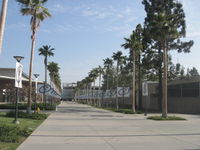 Fullerton |
 Northridge |
Stanislaus |
 Sonoma |
 San Bernardino |
 Bakersfield |
Monterey Bay |
Channel Islands |
Off campus branches

A handful of universities have off campus branches that make education accessible in a vast state. Unlike the typical university extension courses, they are degree-granting and students have the same status as other California State University students. The newest campus, the California State University, Channel Islands, was formerly an off campus branch of CSUN. Riverside and Contra Costa counties, which have 3 million residents between them, have lobbied for their off campus branches to be freestanding California State University campuses. Total enrollment for all branches in Fall 2005 is 9,163 students, the equivalent of 2.2% of systemwide enrollment. The following are schools and their respective off campus branches:
- California State University, Bakersfield
- Antelope Valley (in Lancaster, California)
- California State University, Chico
- Redding (affiliated with Shasta College)
- California State University, Fullerton
- Irvine
- Garden Grove
- California State University, East Bay
- Concord
- Oakland (Professional & Conference Center)
- California State University, Fresno
- Lancaster
- California State University, San Bernardino
- Palm Desert
- California State University, San Marcos
- Southwest Riverside County
- San Diego State University
- Imperial Valley (in Brawley, California and Calexico, California)
- San Francisco State University
- Cañada College (in Redwood City, California)
- Downtown Center (in San Francisco, California)
- California State University, Stanislaus
- Stockton, California [1]
- Sonoma State University
- Ukiah, California
Laboratories and observatories
Research facilities owned and operated by units of the CSU:
- Desert Studies Center
- Research consortium and field site managed by California State University, Fullerton
- official website
- Moss Landing Marine Laboratories
- Independent degree-granting campus managed by San Jose State University
- Oceanographic laboratory located in the Monterey Bay area
- official website
- Southern California Marine Institute
- Oceanographic laboratory in the Los Angeles Basin
- official website
- Mount Laguna Observatory
- Astronomical observatory part of the Astronomy Department of San Diego State University
- official website
- T.S. Golden Bear
- The training ship of the California Maritime Academy
- official website
Former campuses
Former units and campuses of the CSU:
- Los Angeles State Normal School (aka State Normal School at Los Angeles) (founded 1882)
- By state law, converted to UCLA (University of California, Los Angeles) in 1919
- Santa Barbara State College (founded 1909)
- By state law, converted to UCSB (University of California, Santa Barbara) in 1944
Differences between the CSU and UC systems
Both university systems are California publicly funded higher education institutions. Despite having fewer students, some individual UC campuses, as a result of their research emphasis and medical centers, have larger budgets than the entire CSU system. CSU's Chancellor, Dr Charles B Reed, pointed out when delivering his Pullias Lecture at USC, that California was big enough to afford two world-class systems of public higher education, one that supports research (UC) and one that supports teaching (CSU). However, student per capita spending is stretched far thinner at the CSU, and the lack of a research mission or independent doctoral programs under the California Master Plan leads to a perceived lack of prestige among some academics.[20][21] For many of the CSU system's early formative years, the more powerful UC system was able to delay or prevent the CSU campuses from gaining the right to grant bachelor's degrees, then later master's degrees and now doctorates in most fields. Thus while similar campuses in other states (e.g., Arizona State University) eventually grew from normal schools into research-oriented state universities, the UC system's powerful research university monopoly has successfully prevented the CSU from experiencing a similar development. Librarian Emeritus Kevin Starr has described the CSU as "in so many ways the Rodney Dangerfield of public higher education."[22]
According to the California Master Plan for Higher Education (1960), both university systems may confer Bachelors or Master's degrees as well as professional certifications, however only the University of California has the authority to issue Ph.D degrees (Doctor of Philosophy) and professional degrees in the fields of law, medicine, veterinary, and dentistry. As a result of recent legislation (SB 724), the California State University may now offer the Ed.D degree (also known as the Doctor of Education or "education doctorate degree") to its graduate students. Additionally, the California State University (CSU) offers Ph.D degrees and some professional doctorates (for instance, audiology, Au.D) as a "joint degree" in combination with other institutions of higher education, including "joint degrees" with the University of California (UC) and accredited private universities. This is why, for instance, San Diego State can qualify as a "Research University with high research activity" (Carnegie Foundation link) by offering 16 doctoral degrees.
There are 23 CSU campuses and 10 UC campuses representing 414,000 and 191,000 students respectively. The cost of CSU tuition is approximately half that of UC. Thus, the CSU system has been referred to by former California State University authorities as "The People's University."[23]
CSU and UC use the terms "president" and "chancellor" internally in exactly opposite ways: At CSU, the campuses are headed by "presidents" who report to a systemwide "chancellor"; but at UC, they are headed by "chancellors" who report to a systemwide "president".
CSU has traditionally been more accommodating to the older student than UC, by offering more degree programs in the evenings and, more recently, online. In addition, CSU schools, especially in more urban areas, have traditionally catered to the commuter, enrolling most of its students from the surrounding area. This has changed as CSU schools increase enrollment and some of the more prestigious urban campuses attract a wider demographic.[24]
Admission standards
Historically the requirements for admission to the CSU have been less stringent than the UC system. The CSU attempts to accept applicants from the top one-third (1/3) of California high school graduates. In contrast, the UC attempts to accept the top one-eighth (1/8). In an effort to maintain a 60/40 ratio of upper division students to lower division students and to encourage students to attend a California community college first, both university systems give priority to California community college transfer students.
However, as of 2008 the following CSU campuses use higher standards than the basic admission standards because of the number of qualified students who apply to those campuses as first-time freshmen during the initial application filing period:[25]
- California Polytechnic State University
- California State Polytechnic University, Pomona
- California State University, Chico
- California State University, Fresno
- California State University, Fullerton
- California State University, Long Beach
- California State University, Northridge
- California State University, San Marcos
- San Diego State University
- San Francisco State University
- San Jose State University
- Sonoma State University
Impacted Campuses
An impacted campus or major is one which has more CSU-qualified students than capacity permits. As of 2006, CSU Long Beach, San Diego State, and Cal Poly SLO are impacted for both new freshmen and for transfer students, while CSU Fullerton, Cal Poly Pomona, CSU San Bernardino, and Sonoma State are impacted for new freshmen. Thus, these campuses have higher admission standards than the CSU minimum. In addition, some programs at other campuses are similarly impacted. Despite this, CSU undergraduate admissions are quantitatively based and generally do not include items such as personal statements, SAT Subject Test scores, letters of recommendation, or portfolios. In addition, there is geographic preference given to those residing within the commuting areas of the colleges.[26]
Special admissions process for the California Maritime Academy
The Maritime Academy uses a different admissions process from other CSU schools. Because of the nature of its programs, the Maritime Academy requires all applicants to pass a standard physical examination prior to enrollment.[25]
Campus naming conventions
The UC system follows a consistent style in the naming of campuses, using the words University of California followed by the name of its declared home city. Most CSU campuses follow a similar pattern, though several are named only for their home city or county, such as San Francisco State University, San Jose State University, San Diego State University, or Sonoma State University. A few of the colleges follow neither pattern, in particular the California Maritime Academy (Cal Maritime) and the California Polytechnic State University (Cal Poly), the only campuses whose official names do not reference their location in California. Some critics, including Donald Gerth (a former President of California State University, Sacramento), have claimed that the weak California State University identity has contributed to the CSU's perceived lack of prestige when compared to the University of California.[27]
Research and academics
AAU, AASCU and APLU
The University of California and most of its campuses are members of the Association of American Universities (AAU) and the Association of Public and Land-grant Universities (APLU).
The California State University (CSU) and most of its campuses are members of APLU and the American Association of State Colleges and Universities (AASCU).
ABET
ABET, Inc., (formerly the Accreditation Board for Engineering and Technology), accredits post-secondary degree programs in applied science, computing, engineering, and technology. It is intended to certify the quality of these programs. The California State University has 17 ABET-accredited engineering colleges throughout California.[28]
- Cal Poly Pomona College of Engineering in Pomona
- Cal Poly San Luis Obispo College of Engineering in San Luis Obispo
- California Maritime Academy College of Engineering in Vallejo
- California State University, Chico College of Engineering in Chico
- California State University, Dominguez Hills College of Engineering in Carson
- California State University, East Bay College of Engineering in Hayward
- California State University, Fresno College of Engineering in Fresno
- California State University, Fullerton College of Engineering in Fullerton
- California State University, Northridge College of Engineering in Northridge
- California State University, Long Beach College of Engineering in Long Beach
- California State University, Los Angeles College of Engineering in Los Angeles
- California State University, Sacramento College of Engineering in Sacramento
- California State University, San Bernardino College of Engineering in San Bernardino
- Humboldt State University College of Engineering in Arcata
- San Diego State University College of Engineering in San Diego
- San Francisco State University College of Engineering in San Francisco
- San Jose State University College of Engineering in San Jose
Rankings
U.S. News rankings of California State University best undergraduate Engineering programs accredited by the ABET in order.[29]
- Cal Poly San Luis Obispo
- Cal Poly Pomona
- San Jose
- Los Angeles
- Long Beach
- Northridge
CENIC
The CSU is a founding and charter member of CENIC, the Corporation for Education Network Initiatives in California, the nonprofit organization which provides extremely high-performance Internet-based networking to California's K-20 research and education community.
Statewide university programs
Agricultural Research Initiative
- A comprehensive applied agricultural and environmental research program joining the CSU's four colleges of agriculture (at San Luis Obispo, Pomona, Chico and Fresno) and the state's agriculture and natural resources industries and allied business communities.
Biotechnology
- Managed by the San Diego and Chico campuses, the California State University Program for Education and Research in Biotechnology (CSUPERB) provides vision, leadership, and support for biotechnology education and research throughout the CSU to promote biotechnology in California. CSUPERB was created in 1987 and designed to channel CSU system-wide resources and catalyze interdisciplinary, inter-campus, synergistic endeavors involving Biology and Chemistry departments as well as Engineering, Agriculture and Computer Science. The interdisciplinary nature of biotechnology includes areas such as bioengineering; agricultural biotechnology; human pharmaceutical and health applications; environmental and natural resource biotechnology; molecular ecology; marine biotechnology; and bioinformatics and computational biology as they are applied to molecular questions. CSUPERB also recognizes basic research in the molecular and cellular life sciences as contributing to biotechnology, and serves as the official liaison between the CSU system and industry, government, the Congressional Biotechnology Caucus, and the public arena in all biotechnological matters.
Nursing
- Statewide Nursing Program
- Headquartered and administered at the Dominguez Hills campus, the CSU Statewide Nursing Program offers registered nurses courses available throughout California that lead to Bachelors' and Masters' of Science degree in Nursing (awarded by the closest participating CSU campus). See also California Postsecondary Education Committee (CPEC) Reports on CSU Statewide Nursing Program for more information.
Pre-doctoral program
- Designed to increase the pool of potential faculty by supporting the doctoral aspirations of California State University students who have experienced economic and educational disadvantages.
- Provides financial and other assistance to individuals pursuing doctoral degrees. The program seeks to provide loans to doctoral students who are interested in applying and competing for California State University instructional faculty positions after completion of the doctoral degree.
Professional science master's degree
- See PSM degree
The CSU intends to expand its post-graduate education focus to establish and encourage Professional Science Master's degree (PSM) programs using the Sloan model (see link for further discussion).
See also
- California Community Colleges
- California Master Plan for Higher Education
- California State Employees Association
- California State University Emeritus and Retired Faculty Association
- California State University Police Department
- Colleges and universities
- List of colleges and universities in California
- University of California
References
- ↑ "2008-2009 External Support Annual Report: Endowment". calstate.edu. California State University. As of June 30, 2009. http://www.calstate.edu/universityadvancement/reports/0809externalreport/endowment_market.shtml. Retrieved February 26, 2010.
- ↑ Home Page. California State University. Retrieved on December 6, 2008.
- ↑ "The California State University homepage". The California State University. 2006-02-13. http://www.calstate.edu/. Retrieved 2008-08-21.
- ↑ "CSU Facts 2006". The California State University. 2006-06-29. http://www.calstate.ca.gov/PA/2006Facts/index.shtml. Retrieved 2006-07-30.
- ↑ California Education Code, §66602
- ↑ "The CSU Board of Trustees". The California State University. 2008-01-18. http://www.calstate.edu/PA/info/BOT.shtml. Retrieved 2008-01-18.
- ↑ 2006-2007 Annual Report
- ↑ 8.0 8.1 http://www.nacubo.org/documents/research/NES2008PublicTable-AllInstitutionsByFY08MarketValue.pdf
- ↑ http://www.nacubo.org/Documents/research/2009_NCSE_Public_Tables_Endowment_Market_Values.pdf
- ↑ 10.0 10.1 10.2 10.3 "CSU Human Resources. (Fall 2004). Profile of CSU Employees: Fall 2004." (PDF). http://iar.csumb.edu/site/Images/iar/Fall2004CSUProfiles.pdf. Retrieved 2007-08-27.
- ↑ Paddock, Richard C. (2008-05-09). "Ousted Cal State Fullerton teacher revises oath of loyalty: The university says it is willing to work with the Quaker and her attorneys but suggests it may not have a job for her now". Los Angeles Times. http://www.latimes.com/news/local/la-me-oath9-2008may09,0,3786001.story.
- ↑ 12.0 12.1 "CSU Public Affairs Office. (April 3, 2007). CSU, Faculty Union Reach Tentative Agreement on Four-Year Contract.". http://www.calstate.edu/pa/news/2007/tentative.shtml. Retrieved 2007-09-25.
- ↑ "Krupnick, M. (September 20, 2007). CSU executives' salaries raised by up to $45,000. Monterey County Herald.". http://www.montereyherald.com/search/ci_6946074?IADID=Search-www.montereyherald.com-www.montereyherald.com. Retrieved 2007-09-25.
- ↑ Human Resources, California State University Office of the Chancellor, 2005.
- ↑ 15.0 15.1 "California State University, Office of the Chancellor: Human Resources. (2007/2008). Salary Schedule. (p. 48)" (PDF). http://www.calstate.edu/hrpims/salary/SalarySchd20071001.pdf. Retrieved 2007-11-02.
- ↑ CSU | Analytic Studies | In Brief 2008
- ↑ Final Budget Allocations
- ↑ http://www.csusb.edu/aboutCSUSB/EconomicImpact.aspx
- ↑ http://csumb.edu/site/x8338.xml
- ↑ Lindelof, Bill (November 15, 2007). "CSU budget plan might hike fees". Sacramento Bee. http://www.sacbee.com/101/story/493053.html. Retrieved 2007-11-16.
- ↑ Jaschik, Scott (October 18, 2007). "Mississippi State in the Silicon Valley". Inside Higher Education. http://www.insidehighered.com/news/2007/10/18/sjsu. Retrieved 2007-11-16.
- ↑ Kevin Starr, Coast of Dreams: California on the Edge, 1990-2003 (New York: Alfred A. Knopf, 2004), 583.
- ↑ Reed, Ann (Spring, 2003). "Donald R. Gerth to leave the Sac State presidency after nearly two decades". Capital University Journal. http://www.csus.edu/pubaf/journal/spring2003/17gerth.htm. Retrieved 2008-01-02.
- ↑ Saavedra, Sherry (September 23, 2007). "As SDSU evolves, demand for housing grows; University was built as commuter campus". San Diego Union Tribune. http://www.signonsandiego.com/uniontrib/20070923/news_1n23house.html. Retrieved 2008-01-18.
- ↑ 25.0 25.1 "Campuses that have Higher Standards". The California State University. 2008-01-18. http://www.csumentor.edu/planning/high_school/campuses_that_have_higher_standards.asp. Retrieved 2008-01-18.
- ↑ "Impacted Undergraduate Majors and Campuses in the California State University - 2008-2009". The California State University. 2008-01-18. http://www.calstate.edu/ar/impactioninfo.shtml. Retrieved 2008-01-18.
- ↑ Gerth, Donald R.; Haehn, James O. (1971). Invisible Giant: The California State Colleges. Jossey-Bass, San Francisco. ISBN 0-87589-110-1.
- ↑ http://www.abet.org/schoolstate.asp
- ↑ [http://www.cefns.nau.edu/Academic/CS/misc_docs/UG_engineering_ranking_08.pdf Best Undergraduate Engineering Programs spring 2008] Retrieved on October 03, 2009
External links
- California State University
- History of CSU
- California Faculty Association
- California State University Emeritus and Retired Faculty Association
- California State Student Association
|
||||||||||||||
|
|||||||||||||||||||||||||||||||||||||||||

